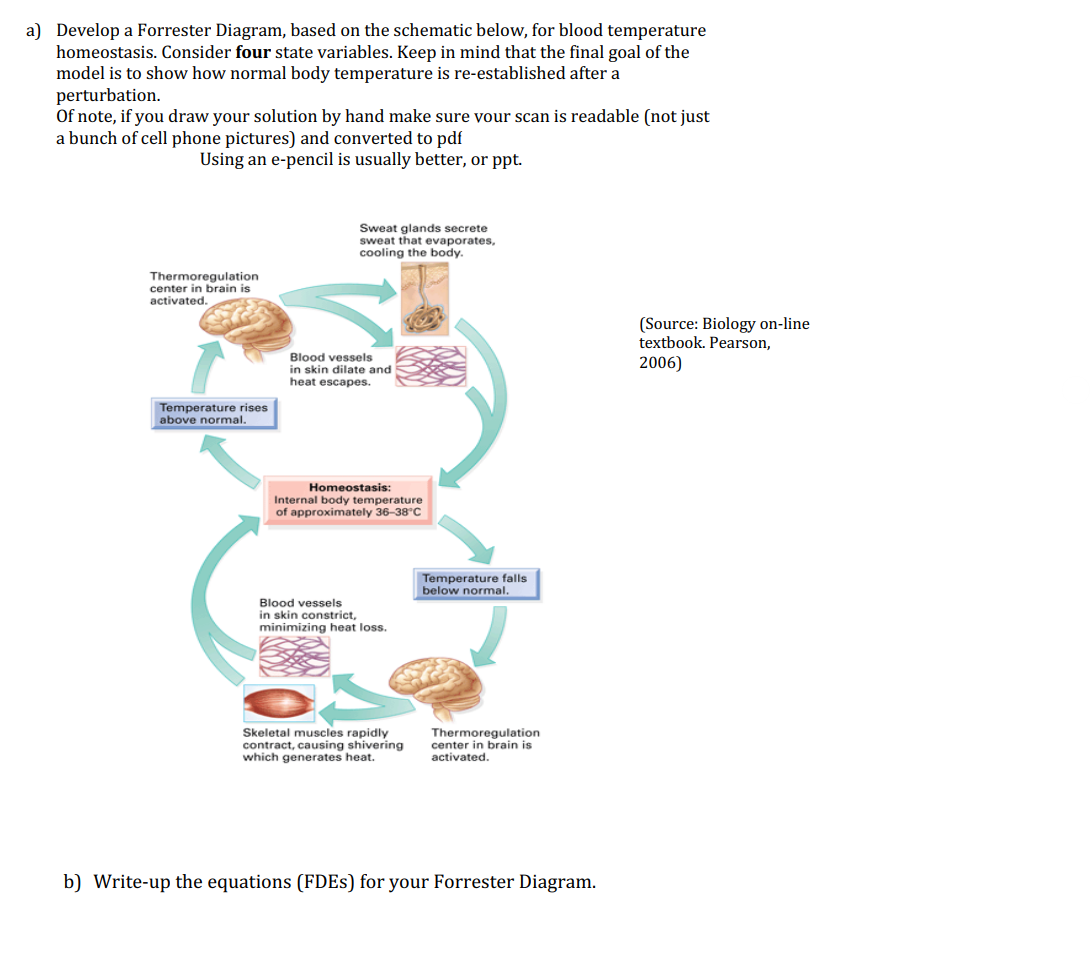Develop a Forrester Diagram, based on the schematic below, for blood temperature homeostasis. Consider four state variables. Keep in mind that the final goal of the model is to show how normal body temperature is re-established after a perturbation. Of note, if you draw your solution by hand make sure vour scan is readable (not just a bunch of cell phone pictures) and converted to pdf Using an e-pencil is usually better, or ppt.
Develop a Forrester Diagram, based on the schematic below, for blood temperature homeostasis. Consider four state variables. Keep in mind that the final goal of the model is to show how normal body temperature is re-established after a perturbation. Of note, if you draw your solution by hand make sure vour scan is readable (not just a bunch of cell phone pictures) and converted to pdf Using an e-pencil is usually better, or ppt.
Human Physiology: From Cells to Systems (MindTap Course List)
9th Edition
ISBN:9781285866932
Author:Lauralee Sherwood
Publisher:Lauralee Sherwood
Chapter11: The Blood
Section: Chapter Questions
Problem 3SQE
Related questions
Question

Transcribed Image Text:a) Develop a Forrester Diagram, based on the schematic below, for blood temperature
homeostasis. Consider four state variables. Keep in mind that the final goal of the
model is to show how normal body temperature is re-established after a
perturbation.
Of note, if you draw your solution by hand make sure your scan is readable (not just
a bunch of cell phone pictures) and converted to pdf
Using an e-pencil is usually better, or ppt.
Thermoregulation
center in brain is
activated.
Temperature rises
above normal.
Sweat glands secrete
sweat that evaporates,
cooling the body.
Blood vessels
in skin dilate and
heat escapes.
Homeostasis:
Internal body temperature
of approximately 36-38°C
Blood vessels
in skin constrict,
minimizing heat loss.
Skeletal muscles rapidly
contract, causing shivering
which generates heat.
Temperature falls
below normal.
Thermoregulation
center in brain is
activated.
b) Write-up the equations (FDEs) for your Forrester Diagram.
(Source: Biology on-line
textbook. Pearson,
2006)
Expert Solution
This question has been solved!
Explore an expertly crafted, step-by-step solution for a thorough understanding of key concepts.
This is a popular solution!
Trending now
This is a popular solution!
Step by step
Solved in 4 steps

Knowledge Booster
Learn more about
Need a deep-dive on the concept behind this application? Look no further. Learn more about this topic, biology and related others by exploring similar questions and additional content below.Recommended textbooks for you

Human Physiology: From Cells to Systems (MindTap …
Biology
ISBN:
9781285866932
Author:
Lauralee Sherwood
Publisher:
Cengage Learning

Anatomy & Physiology
Biology
ISBN:
9781938168130
Author:
Kelly A. Young, James A. Wise, Peter DeSaix, Dean H. Kruse, Brandon Poe, Eddie Johnson, Jody E. Johnson, Oksana Korol, J. Gordon Betts, Mark Womble
Publisher:
OpenStax College


Human Physiology: From Cells to Systems (MindTap …
Biology
ISBN:
9781285866932
Author:
Lauralee Sherwood
Publisher:
Cengage Learning

Anatomy & Physiology
Biology
ISBN:
9781938168130
Author:
Kelly A. Young, James A. Wise, Peter DeSaix, Dean H. Kruse, Brandon Poe, Eddie Johnson, Jody E. Johnson, Oksana Korol, J. Gordon Betts, Mark Womble
Publisher:
OpenStax College


